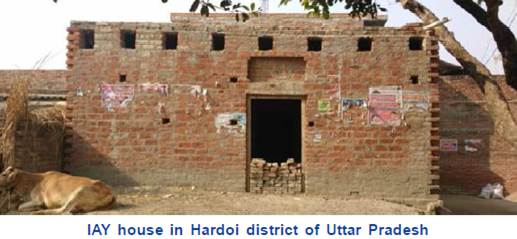|
IAY Housing In Uttar Pradesh T he Indira Awaas Yojna (IAY) is one of the oldest housing schemes of the Ministry of Rural Development (operational since 1985-86) that aims at fulfilling the rural housing demand in India. Of the 75 districts in the state of Uttar Pradesh, 32 districts have a rural population of above 80%. In Uttar Pradesh, a total of 34,482 houses were constructed under IAY between 2012-2015. The district with the highest IAY construction is seen in Kheri district of Uttar Pradesh (12,569 houses) followed by Sonbhadra district (3,694 houses). Based on the mid-term review of IAY during the XI Plan, the quality of housing remains a problem such as sagging foundation, use of temporary materials for roofing or leaving the construction incomplete because of inadequate finance.Currently in Uttar Pradesh, targets for houses constructed under IAY for the year April 2015- March 2016 is 3,58,551 houses (MOSPI, 2015). Development Alternatives under a UNDP funded project studied 300 IAY houses in selected districts of Central India, to understand the state of IAY funded houses. The study revealed: Spatial Layout: Almost 60% of the houses had only a single room and only half of them had a verandah in front. The verandah that forms an integral part of the socio- cultural aspect of people, is not given enough emphasis through IAY houses. Kitchen: None of these houses had a separate kitchen. The cooking area is generally a semi-open space for all the houses. 95% households showed interest in having a separate kitchen. Sanitation Facility: None of the houses had sanitation facility. Building Materials:
Mud being the most readily available material was the most widely
used material for all building components. In 60% cases, owners procured
building materials from local markets within 5 to 7 km. of radius.
Construction techniques: Most of the houses had load bearing construction, typically that of RCC blocks. However, this kind of roofing structures are not ideal in areas which lie in high seismic regions. In all the houses that were surveyed the flooring was of mud, and in some cases cow dung finish was applied. With no pucca flooring, seepage of water was common which caused health issues for the households. None of the houses even had plaster on their walls. Storage facility: Separate storage facilities were lacking with approximately 70% of the houses constructing lofts within their houses to protect grains during the rainy season. Further 25% of the houses that were surveyed aspired to have separate sheds for their cattle. However, the IAY houses had no provision for this request. Problems encountered: Even though the houses were newly constructed, 10% houses were facing structural problems such as rusting of reinforcement bars in slabs, moisture on walls caused by water logging on the roof-top because of wrong slope etc. 15% houses did not have sufficient natural light inside the rooms as people preferred not to have windows in their house due to safety concerns. In fact, 35% houses did not have any window in any of the walls. While the IAY scheme has made commendable efforts to ensure availability of housing for rural households, factors like quality of housing and needs of the rural dwellers and their livelihoods have not been addressed. There thus lies a lack of participatory planning in the construction of the houses and a lack of institutional support in making new alternative eco-friendly technologies and materials available to the households. Besides financial support, no support for material procurement is provided to IAY families. The rural housing scheme requires for a more participatory approach that ensures sustainable habitats and the promotion of locally appropriate and sustainable housing practices. ■ Srijani Hazra References: (http://mospi.nic.in/Mospi_New/upload/RevisedIAYtargets2015-16.pdf) Census of India (2011) |
